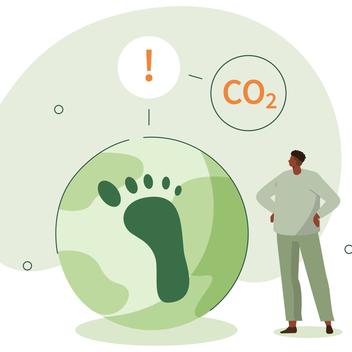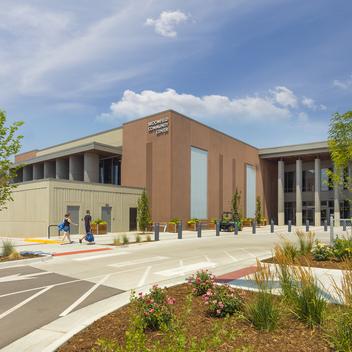Carbon footprint—two consequential words with environmentally conscious design and construction experts evaluating every material specification. Designers and contractors face a dual challenge: creating high-quality, visually appealing buildings that adhere to industry standards while also minimizing their long-term environmental impact. As a result, the industry is shifting towards sustainable building practices.

The Building Lifecycle:
A Holistic Approach
Currently, experts are debating the value of building with energy-saving materials or focusing on reducing a building’s total lifecycle cost as the best method to decrease the lifelong carbon footprint, with each organization setting its own goals concerning Global Warming Potential (GWP) and carbon footprint. Finding the best building solution to reduce impact can be like navigating a maze, with Lifecycle Assessments (LCAs) and Environmental Product Declarations (EPDs) today primarily looking at cradle-to-gate carbon impacts, not accounting for the life of the building. So what is the right solution? When looking at the entire lifecycle and creating a structure to last, prefabricated concrete rises to the forefront.
When this topic started to build momentum, the Precast/Prestressed Concrete Institute (PCI) conducted a study of the energy used in a commercial building from cradle-to-grave. This study compared three structural systems (steel vs. cast-in-place vs. precast) and three envelope systems (curtainwall vs. brick & steel studs vs. various precast enclosure systems).
According to the study’s conclusions, “97% of the total primary energy (TPE) and 96% of the global warming potential (GWP) attributed to the building over its lifetime occurs in the operating energy stage.” Although certain building materials influence the initial carbon footprint due to the energy use and carbon emissions associated with manufacturing, the operation stage of a building uses the most energy over its lifetime. Specifically, once a building is constructed, heating, lighting, and general building usage significantly impact the carbon footprint.
However, a building's lifecycle encompasses its entire journey, from initial design and construction to eventual demolition or repurposing. Each stage presents opportunities to optimize resource use and minimize environmental impact.

This graphic illustrates the full building lifecycle, from raw material extraction to end-of-life stages. The first portion (A1-A3) represents the cradle-to-gate phase, covering material production and manufacturing. The entire lifecycle, including construction, use, and disposal, is the cradle-to-grave. Credit: Emily Lorenz
Prefabricated Concrete: A Foundation for Longevity
Prefabricated concrete offers several advantages that contribute to a building's extended lifespan:
- Durability and Resilience: Concrete is inherently durable, resisting the effects of weathering, fire, pests, mold and severe weather. Prefabricated concrete components are manufactured under controlled conditions, ensuring consistent quality and performance.
- Enhanced Energy Efficiency: Prefabricated concrete, with its inherent thermal mass properties, can be designed with integrated and continuous insulation to optimize energy performance. This combination reduces energy consumption for both heating and cooling.
- Less Maintenance: The building can maintain its aesthetic and structural integrity with minimal upkeep, saving the building owner money while avoiding having to use materials to patch, replace, or repair damaged elements frequently, which further reduces resource consumption and waste over time.
- Adaptability and Flexibility: Prefabricated concrete components can be customized to suit various architectural styles and functional requirements, allowing for future modifications and expansions without needing a new building.
- Life of the Structure: Many buildings are being torn down and demolished before reaching 30 years of life. This wear and tear on environmental resources is exponentially more damaging than when a building can last for multiple future generations. This is where prefabricated concrete buildings are proving their value, with buildings staying structurally sound and viable for over 50 years.
Examples of enduring designs:
Aurora Justice Center

Built in 1988, the Aurora Justice Center remains a testament to the enduring quality of prefabricated concrete. Over 35 years later, photographs taken in 2024 reveal a structure that looks as pristine as it did on day one, showcasing the durability and timeless design of its materials.
American Family Field

Since opening its doors in 2001, American Family Field has welcomed an incredible 58,666,763 fans, cementing its place as a hub for sports and entertainment. The stadium’s use of prefabricated concrete in both its structural and architectural elements, including the stadia risers, ensures it withstands the wear and tear of millions of visitors. This long-lasting material has helped preserve the stadium’s iconic design and safety standards for over two decades.
Chester Fritz Auditorium

The Chester Fritz Auditorium, built in 1971, has become a cherished community landmark, reaching an impressive milestone of over 50 years of service. Its prefabricated concrete construction has not only preserved the building’s structural soundness but also allowed it to maintain its iconic presence on campus as a space that has hosted countless performances and gatherings over the years.
Building for generations to come.
When determining the best solution for sustainable building design, it’s vital to look at the cradle-to-grave impact of a building. With this in mind, prefabricated concrete is in the contender set, offering durability, energy efficiency, and long-term environmental benefits. By using prefabricated concrete building solutions, like precast, architects and contractors can create resilient, adaptable structures that minimize waste and resource consumption while meeting evolving standards to benefit both occupants and the environment.
Interested in learning more about Net Zero Building with Carbon Fiber Reinforced Precast while earning continuing education credits? Join this self-paced online continuing education course provided by our partner, AltusGroup.



